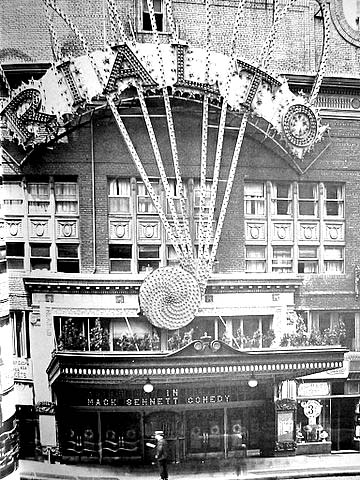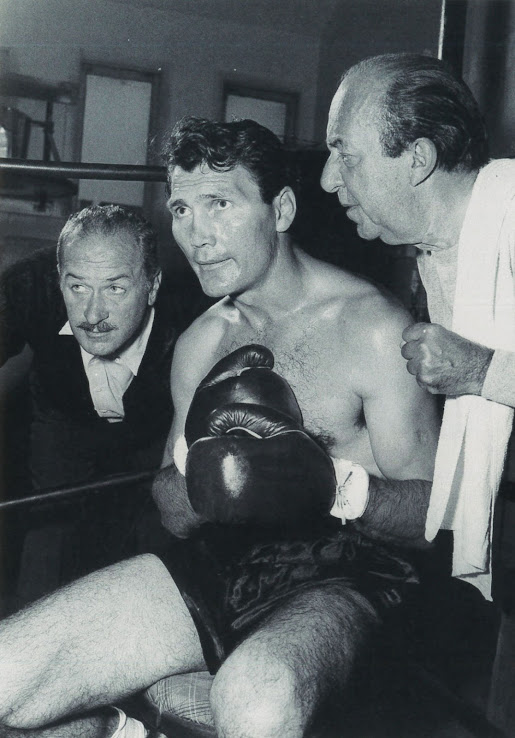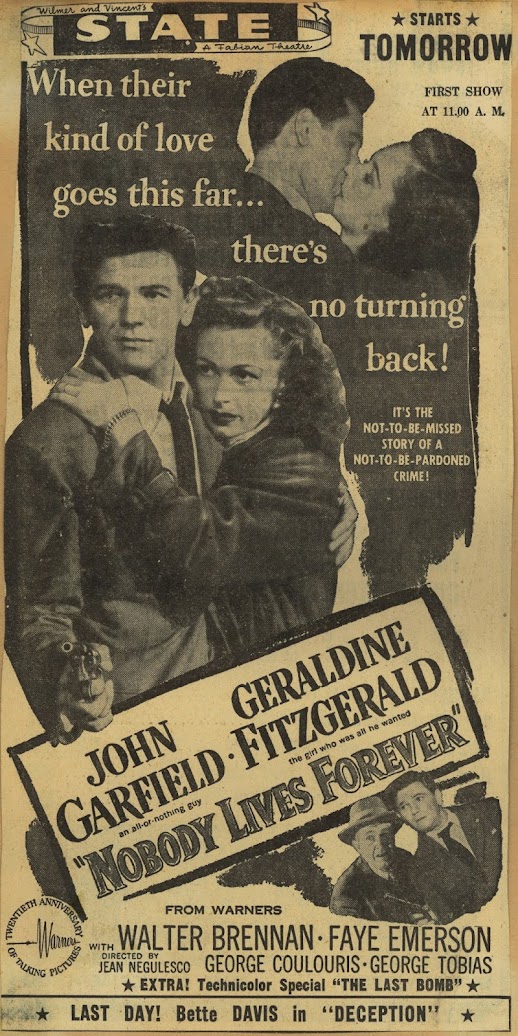Gold Is Where Average Viewers Find It
Critics --- Get To Know Your Audience!
What more useless than critic reviews the product of screening rooms where company was other critics, films they saw not yet put before a retail public. These I skip in favor of notices the fruit of crowded view, where a Mordaunt Hall, Frank Nugent, or James Agee bore witness to crowds lit up by movies they were not paid to evaluate, but themselves paid to enjoy. Plain folk reactions often guided critics as to how they should react. How any film was received by its first-run audience was most valuable data any observer could record. Fans memorialized such events in scrapbooks, while pro scribes who were most perceptive incorporated live and spontaneous response into columns they wrote. Mordaunt Hall did so in 1925 when Valentino came to Broadway’s Mark-Strand with The Eagle, Hall’s reporting a clean break from herds reviewing the film but none of context surrounding it. Frank Nugent found himself hip-deep in hepsters on January 4, 1939 when he settled at the Paramount to ostensibly review Zaza, a Claudette Colbert drama-comedy few cared hoots about, for they were there to see Benny Goodman and his Boys play live on stage. Nugent gave up notion of critiquing Zaza to instead eulogize said hapless non-attraction “rude enough … to disturb the chatter, the hand-clapping, and the rhythmic foot-stamping of an audience that was impatient for Benny Goodman’s orchestra to take the Paramount’s stage again.” Sad was fate of any film backing white hot stage accompany, none so steamy as Goodman at ‘39 zenith of popularity.
Quote Nugent: “Key scenes (of Zaza) were greeted by chants of “We want Benny! We want Benny!” Colbert and company were “received coldly,” love scenes prompting “audience wits (who) took it upon themselves to shout advise, most of it unprintable,” result being “Mr.Goodman and his adolescent following had the Paramount all to themselves … Zaza and its would-be reviewers were simply interlopers.” Nugent was obviously a good sport, realizing as he should that the profile of any film is tied up in its reception by initial audiences. No movie played in a vacuum, even if current circumstance suggests they do, and will, what with streaming the increased way to go. Anyone thinking they know the Val Lewtons and Curse of the Cat People should read a remarkable notice James Agee turned in circa April 1, 1944, his having caught Curse (ideally) at Arthur Mayer’s legendary Rialto Theatre, all-night and day retreat for seekers after screen sensation, Agee there “by pure chance” on what he referred to as “a reviewer’s holiday.” Curse of the Cat People took he and patronage by surprise, for contrary to what the title suggested, this was low-key and sensitive exploration of a child’s dream world, a seeming last of choices the Rialto mob might make. They responded warmly, “showed it in their thorough applause,” said Agee, whose review became as much an appreciation of Rialto clientele as an endorsement for Curse of the Cat People, even to a point of citing the “West Times Square” viewership as a “finest movie audience in the country,” calling them “deeply experienced” where it came to rooting out worthwhile films.
Agee lauded “infinite superiority” of Rialto watchers over what he termed “art-theater devotees --- not to mention … the quality and conduct of Museum of Modern Art film audiences,” him fed up by self-conscious art/quality seekers. So long as there was patronage like the Rialto served, “no one in Hollywood has a right to use the stupidity of the public for an alibi,” Agee maintaining there was always a ready audience for “films as decent and human” as Curse of the Cat People. Among thinking critics then, it looked like a crusade on behalf of Val Lewton and work likely to be misunderstood due to RKO merchandising and theatres appealing to low denominators. Manny Farber boosted Curse to point of comparison with The Song of Bernadette, vision-seeing Jennifer Jones’ performance left wanting beside that of little Ann Carter, whose similar sightings were for Farber more effective and believable. Something about Lewton drew renegade reviewers. They saw how he upturned Hollywood formula from basement level at RKO, a model for those who thought for themselves in an industry largely forbidding step off a chalk line. To like Lewton was to be of his independent stripe. Being fashion choice for critics was no influence, however, upon trade appraisal concerned only by whether product pulled B.O. weight, Curse of the Cat People a distinct letdown by their reckoning.
Those on the inside knew getting customers on board with art mislabeled as horror was a higher hill than quick in-and-out theatres could climb. What two-day run built word-of-mouth even where latter was enthusiastic? Trades figured Curse of the Cat People too elegant for anyone’s good, let alone teens who were “practically the entire patronage” for chill bills where Curse typically placed, consensus opinion as expressed by Indianapolis manager of the Lyric Theatre, Frank Paul. Keep selling simple was not just a best, but an only way to go where hundreds of features passed through your doors per year. No time to cultivate even a most exquisite rose; let uptown critics pluck these at leisure and maybe send gem seekers your way. This was real world of management trying to mollify cat people fans asking why they didn’t get cat people in this movie. Based on such a title, who'd blame them? Trade reviews could be cruel, but they spoke to truth of marketing. “Mediocre” said The Motion Picture Herald and Harrison’s Reports, “unique horror of the original is not recaptured,” added the Herald, Harrison of the opinion Curse “fails to carry the punch” of previous Cat People. Motion Picture Daily warned against drawing parallels with the 1942 chiller, lest fans feel “defrauded,” Curse less a shocker than “a fanciful tale for children.” A real concern was exhibitor attempts to link Curse with Cat People, for that matter any horror, patrons most likely to be alienated once wise to what for them was a ruse. Merit of any film was secondary to its sales potential, trades there to pitch for … or warn against … all to arrive at market. Anything falsely advertised was better avoided. Why invite complaint with horror that was anything but horrific?
Curse of the Cat People stood its Rialto ground for two weeks, where, like most of their attractions, it played as a single. Manager/owner Arthur Mayer (showman colleagues the Brandts had a 25% Rialto interest) kidded his status as “The Merchant of Menace,” fact being virtually all his attractions were NY first-runs, not of highest profile perhaps, but a banquet spread before passerbys lured by Rialto front promotion and wild stunts to sell action/thrill subjects Mayer cleaved to. Curse of the Cat People collected $12K a first week, and so held for a second, which took $8K. Previous tenant Calling Dr. Death, from Universal, merited a three-week stay, arriving just after Return of the Vampire, these typical of product the Rialto played. Mayer and ad-designer, entrance-decorator George Hoffman out-circussed the circus, except Rialto fairground stayed open all night, two entrances from the street plus access from a subway platform beneath the theatre. This was useful for school truants, errant husbands, or whoever was on the run from authority, downstairs a quick getaway to departing trains should anyone come through the front looking for you. Gunshots were commonplace amidst dark Rialto trappings. Mayer’s son acquired usher skills in part by advising amorous couples that they might enjoy greater privacy by retiring to coital confines of the Rialto’s less populace balcony, for which Dad gave him a raise for tact and ingenuity. This was before Mayer tore down the old Rialto, which had begun as Hammerstein’s Victoria, once home to the “Flying Appletons” of Portrait of Jennie fame. The space tumbled from 1,960 seats to 600, sans balcony, part of ultra-streamlining Mayer meant to apply now that ongoing Depression had Broadway by show throats.
 |
| Above Two Images of the Rialto in Earlier Incarnations |
Mayer proved himself a scrapper from early on. He had leased the Rialto from Paramount after being in their employ for years, doing publicity, taking orders. Para brass thought the Rialto washed up, a teens-era barn seldom filled. Mayer began the comeback upon leased receipt and stripped overhead to bare bones, working a deal with distributors to play second-tier product, including Universal’s, the Rialto in receipt of U’s the Music Hall did not want. One of those was The Bride of Frankenstein, which Mayer thought ideal for his mob, but the Roxy wanted it also, and Universal in a venal moment let them book it, result an aggrieved Mayer filing suit to block the engagement. Courts got involved: he wanted an injunction against Bride unveiling on Roxy ground, negotiators from warring sides burning late-night oil toward peaceful resolve. Outcome was the Roxy taking Bride of Frankenstein, the Rialto getting Werewolf of London’s premiere as salve for its pain. Such was contest over goods with exploitation promise, Mayer knowing what sold best and ready to go to the mat for it. He talked about policy … wrote witty accounts for trade chums, Terry Ramsaye at the Herald of long-stand association. Mayer was educated (Harvard), knew culture, but chose to wear it lightly, kicking highbrow notion in the pants for preferred “murder, horror, mystery, and fighting.” He (and patrons) liked comedy too, lower-brow the better. Mayer arranged a mural for Rialto walls to celebrate his “steady and sturdy clientele, primarily male.” To that strategy he applied The Lost Patrol, which other Broadway houses “passed up because it had no women in the cast.” Patrol stayed at the Rialto three weeks to packed seating, a bold stroke against ingrained theory, and it worked. Mayer’s notion that one man’s theatre should reflect his own philosophy, and adhere to it, was a sound one.
The Rialto stuck with single features but loaded up on shorts that would excite male interest, newsreels plentiful, not ones fashion-oriented (unless it was swimsuits), sport reels a best where prizefighting was focus, cartoons always a hit, short comedies so long as they were impolite. News took a spike with fresh war in the 40’s, The Marines at Tarawa a rousing extra with Curse of the Cat People, as was The Hungry Goat, a Paramount Popeye, latter a favorite for the Rialto’s kind of audience. That wall mural featured him, plus the Three Stooges, Laurel and Hardy, along with poised daggers, mad science, vampires, a full course for Rialto diners. The theatre was first-run Gotham host to scare offerings from the mid-thirties through much of the forties. Mayer’s would also be launch pad for Laurel-Hardy feature output, the Rialto first to get Way Out West, Swiss Miss, The Flying Deuces, Air Raid Wardens, others. Super-A’s went elsewhere, for what use did Mayer have for a latest Greer Garson or Paul Muni? He chided the Music Hall for advertising “too dignified,” cursive scroll, white space, and what not. The Rialto took what was trade-known as “sluffs,” humble fare if not outright B’s the big studios generated but did not care to showcase at flagship housing. That’s how Mayer came by, and gave pride of Rialto place, to Arsene Lupin Returns, an MGM runt of 1938 litter that George Hoffman dressed up like a thrill-Vesuvius poised to erupt.
Arthur Mayer got joy from playing “bad” movies, but really, it was those bad movies he respected more than gilt-edge emptiness the lot of too many studio specials. If his offerings were so lousy, why were people so eager to come in and watch them? Mayer during 1941 singled out stuff critics did not like … The Shanghai Gesture, Hellzapoppin,’ Sundown, emphasizing how each were selling strong along Broadway. Further example from his own Rialto, The Wolf Man, spat upon by reviewers, “piled up the year’s outstanding gross” for Mayer, while celebrated Citizen Kane, down several blocks at the RKO Palace, “left most picture-goers either bored or puzzled or both.” New York critics “are too smart,” he said, Mayer summing up that “Movies are a mass art and must be judged by men and women whose pulses beat in rhythm with the heart of humanity.” So who did Mayer think he was? Just someone who had worked this business since the teens. “Most theatres have to sell 100 to 300 pictures annually. They cannot do this with under-emphasis or apology. The day that advertisers in this industry stop believing that every motion picture is the greatest of all forms of entertainment, that day we are all sunk. The day that every producer, whether he is making an A picture, a B picture, or an XYZ picture, regains that faith, that day our worst troubles are over.”
 |
| Unveiling the Rialto's Drawn-To-Ghastly-Measure Mural |
Mayer thought Top Ten lists were largely for birds, lest it was ten most attended or popular among hoi-polloi he catered to. Being one who’d act on rebel impulse, and happy always to travesty taste-makers, he made annual gift of “Rialto Ten Worst,” a Yuletide thumb-to-nose for critics who took cinema too serious. Partying was fuel for Rialto staff, trades filled with recap of whatever Mayer lately celebrated. It could be the venue’s anniversary, a birthday (anybody’s), or just the help saluting their boss for being such a regular guy. Guests came from up-down Broadway-42nd, every hour Happy Hour at the Rialto, as the place never slept. Bookers, brother managers, studio folk in from the opposite coast, even stars who knew where fun was best had (Sir Cedric Hardwicke announcing “Worst” winners for 1939 at a Santa soiree). Rivals by day were common-cause revelers by night. Wonder if critics like Agee or Farber attended a Rialto party … only if they could laugh at themselves, I suspect. Guests could get stewed and not worry about a drive home, hacks or subway mere steps or stagger away. The working show world was a closest of any fraternity because these people ate and slept their trade, yes, drank it too. Selling dreams round clocks was way of life that once engaged, never was parted from. Arthur Mayer stayed a biz course through exhibition, distribution (Euro imports), production (documentaries), consultation (remember his supervising Freud events in 1963?), a memoir (Merely Colossal), plus what was for many a first book on movies, called The Movies, co-written with Richard Griffith. The Rialto, sold by Mayer in 1948 to Brandt interests, demolished since, thrives among annals of splendid showmanship. Best ballyhoo a film could get was got just for opening there, truly a portal to then-viewing paradise. Mayer himself lived ninety-five years, till 1981.
Many Thanks to Lou Lumenick for supplying the Paramount Theatre's Zaza ad.
UPDATE: 5/31/2021 --- 11:10 am --- Ed Watz checks in with as-always fascinating info and some terrific ad images:
Hello John,
Hope this finds you well - we're doing good in our neck of the woods. I just read your latest post on critics critiquing a movie amongst moviegoers - what can I say, it's excellent as always! Your analysis of Arthur Mayer and the beloved Rialto's fare reminded me that my mom had saved some wartime issues of the NY Daily News that I enjoyed paging through as a kid. I recalled that one paper in particular intrigued me -- inside was a 1945 ad for Laurel & Hardy in THE MUSIC BOX. Faulty memory told me this attraction played The Rialto - it didn't - it played The Laffmovie house - close enough proximity to The Rialto - but regardless, as a kid I was reassured that Bill Everson's (and others) claim that L&H were cast aside by '40's audiences in favor of modern comics like Abbott & Costello, Bob Hope, Danny Kaye or Red Skelton doesn't hold true.


































































